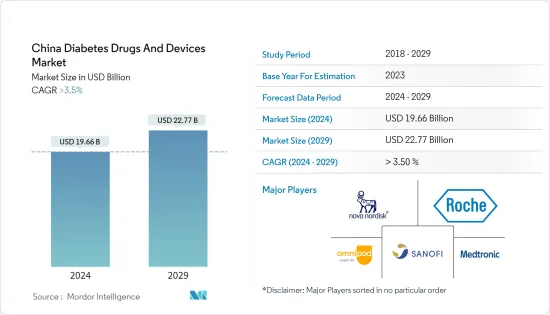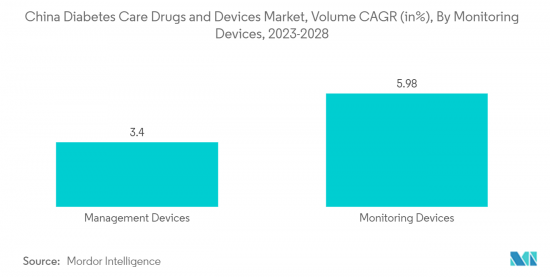PUBLISHER: Mordor Intelligence | PRODUCT CODE: 1408322

PUBLISHER: Mordor Intelligence | PRODUCT CODE: 1408322
China Diabetes Drugs And Devices - Market Share Analysis, Industry Trends & Statistics, Growth Forecasts 2024 - 2029

The China Diabetes Drugs And Devices Market size is estimated at USD 19.66 billion in 2024, and is expected to reach USD 22.77 billion by 2029, growing at a CAGR of greater than 3.5% during the forecast period (2024-2029).
Diabetes affects about one out of every ten COVID-19 patients in China. Diabetes is linked to an increased risk of serious disease and death. The current study suggests that COVID-19 individuals with diabetes require focused early intervention. According to Peking University (Beijing, China), research, intensive care unit (ICU) patients had an approximately threefold higher prevalence of diabetes than non-ICU patients. Various studies on the prevalence of diabetes have diverse results.
During the quarantine period, about 60% of persons with diabetes encountered food or medicine shortages, much greater than those without diabetes. Various studies on the prevalence of diabetes have diverse results. During the quarantine period, about 60% of persons with diabetes encountered food or medicine shortages, which was much more significant than those without diabetes. Notably, respondents who reported medication shortages had a 63% higher rate of COVID-19 infection.
Type 1 diabetes patients will account for more than 9.5% of China's overall diabetes population in the current year. Blood glucose swings among insulin users are common in China owing to lifestyle and eating habits, and self-monitoring of blood glucose fails to adequately reflect the blood glucose profile since it only shows the glucose concentration at a single time point.
China has the highest number of diagnosed and undiagnosed diabetes cases in the world, as per Diabetes Research and Clinical Practice. The number of diagnosed diabetics in China has increased by 56% from 2011 to 2021. Over 75% of adults with diabetes reside in low- and middle-income countries. Diabetes-related health expenditures have surged by 316% to USD 966 billion globally over the past 15 years, with China ranking second with USD 165.3 billion.
Thus, a trend in the demand for diabetes drugs in China has been noted. In the pharmaceutical sector, insulin has a substantial market share. Insulin is used by around 100 million individuals worldwide, including all Type 1 diabetes patients and 10% to 25% of Type 2 diabetic patients. Insulin production is exceedingly complex, with just a few insulin manufacturers on the market. As a result, there is tremendous competition among these companies, which always seek to meet patient requests by offering the highest-quality insulin.
Thus, the above factors are expected to drive market growth over the forecast period.
China Diabetes Drugs And Devices Market Trends
Continuous Glucose Monitoring Segment Expected to Witness the Highest Growth Rate Over the Forecast Period
Continuous blood glucose monitoring is a popular alternative to commercially available portable finger glucose meters for people with diabetes. The sensor is the most important part of any continuous blood glucose monitoring device. Various glucose sensor technologies are being developed, ranging from traditional electrochemical glucose sensors to new optical and other electrical glucose sensors, positively impacting market growth.
Continuous blood glucose monitoring sensors have opened new scenarios for offline assessment of the efficacy of treatment regimens for individual patients, facilitating the development of innovative online applications. This includes a hypoglycemia and hyperglycemia warning system and an artificial pancreas control algorithm. With new technologies, continuous blood glucose monitoring devices are becoming increasingly inexpensive. Patients with type-1 diabetes (T1D) must maintain healthy lifestyle conditions, which depend on personality traits, social interactions, socioeconomic circumstances, and environmental living factors.
Continuous glucose monitoring (CGM) with multiple daily injections (MDI) reduced non-severe and severe hypoglycemia in people with T1 diabetes prone to this adverse event. Patients with type-1 diabetes at high risk of hypoglycemia could control their blood sugar levels even amid the harsh living circumstances imposed by the COVID-19 pandemic crisis' severe lockdown by using standalone continuous glucose monitoring. A slight improvement in geometric markers, particularly those connected to glucose exposure, was linked to lockdown time.
Chinese hospitals ordered CGM devices to limit staff contact with many diabetic patients infected with COVID-19. Blood sugar meters (BGMs) and strips monitor a person's blood sugar level at the precise moment of checking. They insert a test strip into a meter, use a lancing tool to prick their fingers to draw blood, and then place a tiny drop onto the test strip.
Treatment for viral infections in diabetics might be challenging because of BG level variations. With RT-CGM, monitoring BG trends and stopping drastic fluctuations in glucose levels before they cause problems is possible. The Dexcom G4 Platinum CGM system's ability to watch from up to 6.0 m reduces the requirement for medical personnel to enter the isolation room. These factors are driving the monitoring device market in China. The number of generic manufacturers in the nation is significantly rising, and type-1 diabetes patients are increasingly favoring cost-effective treatments, boosting the expansion of the market under study.

Rising Diabetes Prevalence in China Driving the Market
China has witnessed an alarming increase in the prevalence of diabetes in recent years. Patients with diabetes require many corrections throughout the day to maintain nominal blood glucose levels, such as oral anti-diabetic medication or the ingestion of additional carbohydrates by monitoring their blood glucose levels. The rate of newly diagnosed Type 1 and Type 2 diabetes cases has increased. The rapidly increasing incidence and prevalence of diabetic patients and healthcare expenditures are indications of the increasing usage of diabetic drugs.
China includes the world's largest population with diabetes, which continues to grow with the country's rapid urbanization. The Chinese Ministry of Health established a network of National Demonstration Areas to develop pilot projects for health promotion, detection, and control of chronic diseases. Various local government departments and country officials are responsible for overall coordination. Primary care providers promote education and self-management of health conditions through appropriate dietary changes, control of tobacco use, and physical activity, which are beneficial for diabetes control.
As a long-term strategy, China is extending efforts to promote health and detect and control diabetes through academic medical centers (AMCs) and hospitals with effective primary care. AMCs are usually overcrowded with patients with simple conditions, while the primary care system is under-equipped with basic medical infrastructure and an under-qualified workforce. The State Council encouraged health system integration by promoting a hierarchical medical system, a policy that attracts more patients to primary health centers before proceeding to AMCs.
The above factors will likely result in continued market growth.
China Diabetes Drugs And Devices Industry Overview
Manufacturers have constantly innovated to survive in the market. Large companies such as Abbott and Medtronic have made numerous mergers, acquisitions, and partnerships to gain market dominance while adhering to organic growth strategies in the diabetes devices market. The market for diabetes drugs is fiercely competitive, as numerous prominent companies vie for a slice of the market. These companies prioritize the development of groundbreaking drugs and treatments to cater to the ever-changing requirements of diabetes patients. A handful of key players hold sway over the competitive landscape in this industry. To expand their market share, these players employ various strategies such as making investments, forming alliances, engaging in acquisitions, and pursuing mergers.
Additional Benefits:
- The market estimate (ME) sheet in Excel format
- 3 months of analyst support
TABLE OF CONTENTS
1 INTRODUCTION
- 1.1 Study Assumptions and Market Definition
- 1.2 Scope of the Study
2 RESEARCH METHODOLOGY
3 EXECUTIVE SUMMARY
4 MARKET DYNAMICS
- 4.1 Market Overview
- 4.2 Market Dynamics
- 4.2.1 Market Drivers
- 4.2.2 Market Restraints
- 4.3 Porter's Five Forces Analysis
- 4.3.1 Bargaining Power of Suppliers
- 4.3.2 Bargaining Power of Consumers
- 4.3.3 Threat of New Entrants
- 4.3.4 Threat of Substitute Products and Services
- 4.3.5 Intensity of Competitive Rivalry
5 Market Segmentation (Market Size by Value - USD)
- 5.1 Devices
- 5.1.1 Monitoring Devices
- 5.1.1.1 Self-monitoring Blood Glucose Devices
- 5.1.1.2 Continuous Blood Glucose Monitoring
- 5.1.2 Management Devices
- 5.1.2.1 Insulin Pump
- 5.1.2.2 Insulin Syringes
- 5.1.2.3 Insulin Cartridges
- 5.1.2.4 Disposable Pens
- 5.1.1 Monitoring Devices
- 5.2 Drugs
- 5.2.1 Oral Anti-Diabetes Drugs
- 5.2.2 Insulin Drugs
- 5.2.3 Combination Drugs
- 5.2.4 Non-Insulin Injectable Drugs
6 Market Indicators
- 6.1 Type-1 Diabetes Population
- 6.2 Type-2 Diabetes Population
7 COMPETITIVE LANDSCAPE
- 7.1 Company Profiles
- 7.1.1 Novo Nordisk
- 7.1.2 Medtronic
- 7.1.3 Insulet
- 7.1.4 Tandem
- 7.1.5 Ypsomed
- 7.1.6 Novartis
- 7.1.7 Sanofi
- 7.1.8 Eli Lilly
- 7.1.9 Abbottt
- 7.1.10 Roche
- 7.1.11 Astrazeneca
- 7.1.12 Dexcom
- 7.1.13 Pfizer
- 7.2 Company Share Analysis
8 MARKET OPPORTUNITIES AND FUTURE TRENDS




